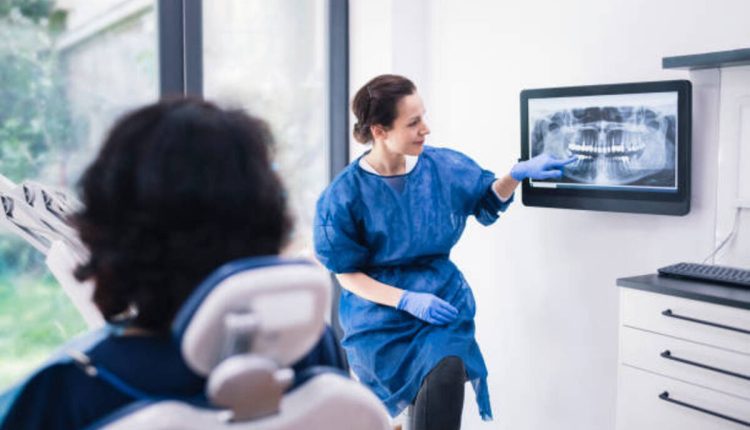Dental x-rays can detect hidden abnormalities such as tooth decay, bone loss, and gum disease. In addition, x-rays can reveal any impacted or extra teeth as well as some forms of tumors. Discover the best info about رادیوگرافی دنداپزشکی.
Studies have confirmed that x-rays are safe when used correctly; it is, however, essential to understand their potential risks.
How X-Rays Are Taken
X-rays allow us to see parts of our mouth that cannot be seen with the naked eye. They produce images of teeth and the surrounding bone. Modern dental X-rays use significantly less radiation than earlier generations, and we adhere to strict guidelines to minimize your exposure.
At our clinic, during a typical X-ray exam, we will first place you in a lead apron to protect your body before asking you to bite down on a small piece of plastic that holds the X-ray film in place. Next, our machine will be placed above your head and jaw; after pressing a button for imaging, we’ll hear a beep! The procedure usually only lasts a few seconds!
Your dentist can then examine the X-ray on a monitor using a computer and decide what treatment, if any, may be needed. We can also digitally compare new X-rays of your teeth with previous ones for easier detection of problems like cavities between two teeth (subtraction radiography). Furthermore, we can send copies of this X-ray directly to other physicians or specialists for review purposes.
How Much Do They Expose You?
X-rays only expose you to minimal doses of radiation. While this may seem alarming, the benefits far outweigh any possible risks.
Dental X-ray radiation exposure is extremely minimal compared to everyday life exposures such as eating bananas, which produce 0.01 millisieverts of exposure, or flying between New York and Los Angeles, which generates ten millisieverts of radiation exposure.
Radiation poses two categories of health risks to humans: deterministic and stochastic. Deterministic risks require high exposure levels that lead to cell killing; stochastic risks might appear after lower exposure, such as cancer or gene mutation, potentially increasing health risks [1].
Recent research indicates that long-term, low-dose exposure to dental imaging (mainly digital X-rays) poses risks. Although the study didn’t demonstrate causation, its results suggest an association between cumulative low-dose exposure and an increase in disease risks and decreasing overall patient dose exposure. Dentists typically follow the principle known as ALARA to ensure their patients receive as low a dose as possible while using patient history and physical examination results to make judgment calls on whether an X-ray examination would be helpful in detecting hidden abnormalities like cysts or tumors that cannot be seen with naked eyes alone.
What Can We Do to Reduce Your Exposure
X-ray exposure poses only minimal risks when compared with overall radiation exposure from all sources (both human-made and natural); however, repeated dental radiographs can have an additive effect that must be minimized through patient protection measures and other means.
Digital x-rays offer lower radiation exposure levels for both the operator and patient than traditional film-based x-rays due to shorter exposure times that limit how much radiation is absorbed into patient bodies.
Additionally, dentists take extra precautions to shield patients’ salivary glands and thyroid from radiation by employing lead aprons or thyroid collars during radiographs; this ensures the safety of all patients, particularly pregnant women.
Though some individuals may worry about dental radiographs being exposed to radiation, they are an indispensable way to detect and prevent problems like cavities and gum disease. Thanks to modern technology and careful dose administration by dentists, dental radiographs are now safe for all patients, including pregnant women.
Patients can further limit their radiation exposure by keeping an X-ray history card. This card should include information such as the date, type of exam, referrer physician, facility, and where images are kept. Showing this card to healthcare professionals may help avoid unnecessary imaging of similar areas.
How Often Do You Need X-Rays?
There is no easy answer regarding when and why x-rays should be performed. Professional dental organizations do provide some guidelines regarding frequency, but these recommendations may need to be adjusted depending on individual health needs and past experiences of oral disease.
Adults without signs of tooth decay or gum disease typically need only be seen every two to three years for bitewing x-rays; however, it would still be wise to get one taken as early problems such as cavities may be detected before becoming more serious issues.
Radiation exposure during an x-ray exam is minimal and continues to decrease, thanks to advanced equipment. Your dose is comparable to what you would experience during a plane flight; thus, it should not increase the risk of cancer.
X-rays are part of your regular checkups, and their frequency depends on factors like your age, dental history, and signs and risks of disease. If you suffer from medical conditions like diabetes or heart disease, more regular X-rays may be needed; it is always wise to consult your dentist regarding this matter, as they will have up-to-date recommendations tailored specifically to you.


